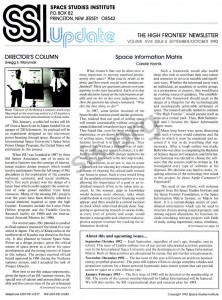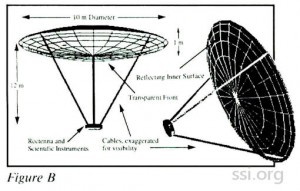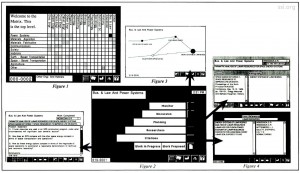SPACE STUDIES INSTITUTE
P.O. BOX 82
PRINCETON, NEW JERSEY 08542
[[librarian note: This address is here, as it was in the original printed newsletter, for historical reasons. It is no longer the physical address of SSI. For contributions, please see this page]]
SSI UPDATE
THE HIGH FRONTIER® NEWSLETTER
VOLUME XVIII ISSUE 5 SEPTEMBER/OCTOBER 1992
DIRECTOR’S COLUMN
Gregg E. Maryniak
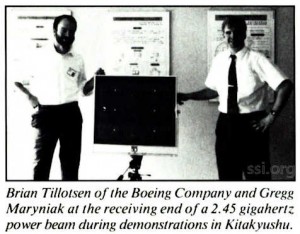
This January, a solid-fuel rocket will lift off from a launch site in Japan headed for an apogee of 220 kilometers. Its payload will be an experiment designed to test microwave power beaming through space. Because of the International Space University’s Space Solar Power Design Program, the United States will participate in this project.
When ISU was founded in 1987 by three SSI Senior Associates, one of its most innovative features was the concept of international student design projects which would involve participants from the full range of ISU disciplines in the exploration of the complex technical, economic and social problems. ISU’s first such project was the design of a lunar base which could support the construction of solar power satellites from lunar resources. Many of the ensuing ISU projects over the years have been directly related to crucial elements required to open the high frontier. Examples include the Lunar Polar Orbiter program and the Variable Gravity Research facility (in 1989) and the International Asteroid Mission (in 1990).
For several years, ISU planned to conduct its final summer session (of the initial five-year series) in Japan. The city of Kitakyushu on the northern tip of Kyushu was chosen as the host city. It also planned to feature Space Solar Power as a design project, given the critical nature of space power as a driver for space development and the strong interest of Japan in this subject. The project received official board approval in 1991 during the Toulouse summer session, and I accepted the task of Project Director.
How best to use this unique opportunity, given the rigors of an ISU summer session, the special mix of talents and personalities available and the current state of the art in beamed power and solar power satellites? Working with SSI Senior Associate and Principal Investigator, Dr. Gay Canough (another ISU veteran), we drafted a plan to explore nearterm opportunities which can ultimately lead to large-scale space power supply to the Earth.
We also began the process of recruiting an international faculty which included over 30 of the world’s experts in space power. Project faculty came from Europe, Japan, Russia and North America and included such champions of solar power satellites as Peter E. Glaser, Makoto Nagatoma of ISAS and Dieter Kassing of ESA. Dr. William C. Brown, the dean of microwave power transmission technology (and a long-time Institute supporter), worked with the Center for Space Power at Texas A&M University to provide a power beaming demonstration experiment for our use in Japan.
This past spring I traveled to Japan to meet that nation’s space power community. These meetings laid the foundation for strong support and participation by Japanese researchers in the program. In the course of the meetings I visited ISAS, The Institute for Space and Astronautical Sciences near Tokyo, home of many interesting space power programs in development including the Space Free Flyer Project and the Microwave Garden longterm biological test program.
Upon settling in at the International Conference Center in Kitakyushu, we learned that 97 students from 26 countries had elected to participate in this project. Our project staff included students from previous ISU sessions. For example, Eric Dahlstrom of the Lockheed Corporation (one of the original SSI Senior Associates), served as a Project Assistant, and quickly acquired a reputation for hard work as well as in-depth knowledge of the subject.
Design project presentations began with briefings from the Japanese space power community on their work and plans. Dr. Hiroshi Matsumoto of the Radio Atmospheric Science Center described MILAX, the new microwave powered experimental airplane which made its maiden flight under radio-frequency power just after the conclusion of our summer session. Dr. Nagatomo showed SPS 2000, a 10 Megawatt mini SPS concept under consideration in Japan.
In addition to in-person presentations, students watched special videos prepared by Fred Koomanoff of the U.S. Department of Energy (manager of the NASA-DOE SPS studies), and SSI former Director, Dr. T.S. Cheston, on international means of frequency allocation. We also experimented with realtime video links using a system designed and provided by PictureTel. This enabled a lecture to be delivered from Boston by Dr. Peter E. Glaser. Later the same system was used to meet with eight crewmembers of Biosphere 2, who were approaching the first anniversary of their closure within the experiment.
With the assistance of our Russian faculty members, one team developed a plan for a near-term space to space power beaming experiment, which would use the Mir space station with a Progress cargo vehicle (Figure A).
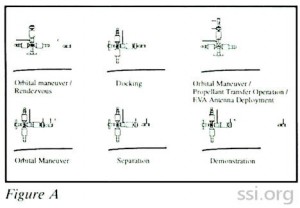
In addition to exploring other space to space and space to ground systems, an effort led by former SSI intern and Princeton University student, Keith Rogers, looked at ways to experiment with atmospheric power beam propagation at low cost. Keith suggested leaving the large transmitting array on the Earth’s surface and sending the energy to a microspacecraft which could be deployed from a ‘Getaway Special’ or Ariane small payload launch (Figure B).
After much negotiation with the Japanese equivalent of the Federal Communications Commission, we received permission to operate the power beaming demonstration apparatus which had been loaned through the Center for Space Power. When the student community had the chance to see the equipment operate and observe the simplicity of the rectenna, it had a profound effect on their perception of space solar power.
The students’ experience underscored a conclusion which they had already reached: demonstrations of space power systems are absolutely required in order to progress with real working space systems. Demonstrable hardware experiments are needed not only to make technological progress, but more importantly, to reduce the real and perceived business and societal risks which are the primary barriers to space power implementation. These early systems can also bridge the gap between pure experimentation and mid – to long-term profitability from solar power satellites and beamed power for space stations and planetary bases. It will be particularly useful if they can also provide real economic value such as enhancing the power levels of end-of-life comsats. Successful, long-term operation of such demonstration systems will educate the public and reduce the fear-factor involved with this new technology.
While the students were exploring the potential of cooperative international space power experiments, the project faculty and staff were working to create a real experimental opportunity. Having arranged for our visiting lecturers from the United States to visit with their Japanese counterparts, we were pleased to learn about a chance to fly a US experiment aboard a Japanese launch. ISAS has been planning an experiment called METS (Microwave Energy Transmission in Space) for launch in early 1993. Using an advanced solid state phased array, a suborbital rocket will beam a kilowatt of power to a ‘daughter’ vehicle previously separated from the parent ship. A fax from the US alerted us that if we could raise a modest amount of support to cover a rapid, ‘skunk-works’ development and construction effort, the US could participate in METS by flying a space rectenna.
The catch was that in order to meet the tight schedule required for a January launch, we had literally 4 days in which to find the necessary support. With the help of our NASA Lewis Research Center faculty and staff, we beat the support deadline with 2 hours to spare! One day after our students received their certificates, design and construction of the rectenna was initiated in Texas. As we go to press the fabrication is complete, and ground testing is underway.
The results of the METS experiment will be shared internationally. An early report is expected at the Wireless Power Transmission Conference which will be hosted by the Center for Space Power in San Antonio, Texas, in February of 1993. The Institute is a cooperating organization for this exciting conference. For further information, call the Center at xxx-xxx-xxxx.
The SSI family can take great pride in having provided a catalyst for this landmark space power experiment. The Institute provided vital support for the Space Solar Power Design project and SSI’s staff assisted in many ways. It was therefore fitting that the ISU students dedicated the 530 page Project Final Report to the memory of Dr. Gerard K. O’Neill.
Note: Copies of the 530 page final report of the Space Power Program are available for $75, postpaid, from ISU Headquarters, 955 Massachusetts Ave., Cambridge, MA 02139.
[[librarian 2016 note: This report is available for free download from the International Space University Library at https://isulibrary.isunet.edu/opac/index.php?lvl=notice_display&id=4663 ]]
Space Information Matrix
Carole Hornik
What research that can be done now is most important to moving mankind permanently into space? What exactly needs to be done, and how much crucial work remains unfinished? These are questions almost everyone aspiring lo the stars has asked. Each of us has made decisions based on the information available and on his or her own judgement, but then the question has always remained, “Was this the best thing to do?”
In 1987, some Senior Assciates of the Space Studies Institute posed similar questions. They realized that our goal of settling space will remain unattainable without convincing research directed toward proving it can be done. They found that, even for those who grasp the importance, or are drawn by the epic character of settling space, finding an effective way to become involved is in itself daunting. They realized that, without a rational way of making or justifying our research choices, it is difficult to determine which choices needed to be made, much less which is the next step to take.
The solution, as we saw it, was to create a framework for selecting key research projects a means of charting the critical path toward our future in space. Such a system would bring all the available information together in a way allowing the importance of a goal or an individual research effort to be taken into account. In this manner, gaps in knowledge would become more obvious, tasks which could be done at every level of financing would appear, and there would be a central location to check which others had already done. Suggesting or sponsoring research in various fields, at every level of priority and scope, would become a manageable and coherent endeavor, given a support structure for tracking the information involved.
Such a framework would also enable those who wish to contribute their own talents and resources to do so in suitable and significant ways. Whether the interested party were an individual, an academic or activist group, or a corporation or country, they would have an evolving source of guidance. The establishment of this framework should result in the design of a blueprint for the technologically and sociologically achievable settlement of space. The research actually needed to colonize “The High Frontier” would present itself as steps on a critical path. Thus, Bob Summersgill and I became the Space Information Matrix team.
Many long hours were spent discussing what such a system would comprise and the ways in which it must be organized and accessed if it was to do everything that was necessary. After a rough outline was made, Bob (who was close to completing his Bachelor of Science degree in Computers and Information Systems) was elected to choose the software that the system could be written in. He investigated every type of software at his disposal. His decision was hard to make, requiring selection of the technology best suited to this project: he chose Apple Computer’s® Hypercard.
The result of our efforts, with welcome support from the Space Studies Institute and the Space Frontier Foundation, is the Space Information Matrix System, or Matrix for short. It is a custom design source of coordinated information which can be used to structure choices among research projects, and among support allocations. Its functions include correlating relevant projects with fields of study, noting importance, status, timeliness, personnel, and more. This means of organizing makes gaps in research and unappreciated lines of investigation more apparent, and allows volunteers working toward space development to select appropriate tasks. As more and more decisions about importance and timeliness are made, a “critical path” evolves.
Our approach to and challenge in structuring the massive amount of information comprising the body of relevant space research has been to create order while encouraging open-mindedness and flexibility; to allow change and restructuring whenever necessary even as the system organizes. The Matrix is designed to adjust continually as knowledge and purpose evolve.
You might get a clearer image of what the Matrix does if you think of all the categories of information needed to permanently settle large numbers of people in space as rooms in an immense building. Think of the Matrix as an elevator which not only goes up and down, but left, right, and diagonally, which also takes you to the side of the room you wanted to go to, not just the doorway. Because all the rooms are in the same building, it is easier to find the room you need.
What follows is the essence of a paper presented by the Space Information Matrix Team at the Tenth Princeton/AIAA/SSI Conference. It is published in the proceedings volume, Space Manufacturing: Energy and Materials From Space, pages 38-42. It describes the Matrix.
The Matrix is initially accessed through its opening screen grid (see Fig. 1). Each of the individual headings on one axis represents a class of projects, and on the other, a class of disciplines. Their intersection is called a “cell” and is the basis for finer and finer resolution within the Matrix (Fig. 1). Each cell on the grid potentially contains many sub-grids, which break down the cell into even more specific projects and disciplines, and cell directories which allow access to the basic information within a given cell.
Cell directories are accessed by selecting a cell or sub-grid. Within a directory, the following range of information (Fig. 2) is available: contact data for the Monitor (the individual responsible for all information and priorities in that block); similar information on researchers and authors of the various abstracts included in this section; assessed priorities for this section only shown in the planning section by a PERT chart, Fig. 3 (and in the future, other charts); and all titles of all the abstracts entered under this heading, sorted into the groupings of “work completed,” “work in progress,” and “work proposed.” From every abstract (Fig. 4), there is access to a bibliography, a list of prerequisite projects, and an index of “key words.” From every entry, a list of key words are drawn and added to the key word index. All papers which use any given key word are associated with each other on that key word’s index card in the “Key Word Directory.”
Information in the Matrix may be accessed through the Key Word Directory, through the Authors/Researchers list, or by subject from the Main Grid. In the future, information will be available by looking up by abstract title or citational reference.
The essential element of a framework which helps prioritize research projects is its organizing power – hence the “deep” grid arrangement of the Matrix, continually encouraging both broadening and narrowing of focus in searching out key projects. It also provides very broad, yet carefully relevant, crossreferences. This framework is extremely flexible and open to alteration, evolution, and fundamental debate. Whether or not there is agreement on a particular item, this approach provides a reasonable starting point.
A Demonstration
The Matrix is designed to help structure choices of research. A project’s importance and its completion status are the basis for the rational selection of tasks to be undertaken. Evaluations along these lines of any project to be abstracted and entered in the Matrix are made by the abstractor and the Monitor for the section in which the project falls. The PERT chart indicates the importance of the project to the over-arching goal and whether anyone has undertaken the project or completed the research. (Funding and man-hour requirements are not shown on this chart, but a quick reading of any proposed project offers some indication).
The importance of the Monitor to this process cannot be overstated. It is the Monitor who constantly draws the dependent connections, evaluates a project’s importance, and determines what is necessary to proceed. It is this process that makes gaps in research and heretofore unappreciated lines of investigation apparent.
Consider the example of an investigation into the societal impact of solar power satellites and their rectennas. One aspect of this topic is to determine how solar power satellites (SPS) can best be presented to avoid public rejection. Research supporting the fact that a microwave beam has no significant negative environmental or ecological impact is important to preventing public rejection of solar power satellites. Investigation into the environmental effects of beamed power is a prerequisite project under rectenna research. Various efforts of this nature are listed as “completed” in the Matrix but the number and scope are limited.
Pressing the subject still further, a proposed project has been generated from this observation. This potential project states that a simple experimental set-up must be developed that will make it easier for graduate-level research in this field and suggests certain characteristics this device should possess. Among these are: an experimental mechanism small enough to exist in a typical college laboratory; the generation of a microwave beam capable of adjustment over the frequency and power ranges at which power might be transmitted; a beam wide enough to accommodate plant growth and animal movement; and, of course, low cost. Finally, it suggests investigating whether conventional microwave ovens can be altered sufficiently for this purpose.
The Matrix lists no “higher” project entirely dependent upon this “lowest level” microwave oven project, but please note, it is possible for a skilled volunteer to pursue this effort without great financial investment. Once undertaken, the project status is changed from “proposed” to “in progress” so that other researchers know that someone is working on it and can, if they wish, provide assistance. If the investigation is successful, proliferation of the necessary lab equipment may result, leading to more and more useful studies, which may be employed to help promote public acceptance of SPS. Thus, very high benefit-tocost and benefit-to-risk ratios have been discovered, amid less-than-obvious decision factors.
Upon submission of this experimental design, the change in status from “in progress” to “completed” will be noted. At that time, the projects dependent upon it will be reevaluated. If the research is successfully completed, another step upon this portion of the critical path has been taken and the next step can begin. If research is unsuccessful, then other alternatives must be developed and explored, but the first route and its lack of success will be noted so that the next researcher will try a different direction.
Of course, anyone could have developed this train of research, even without the Matrix. The truly significant development is the fact that the Matrix encourages this kind of thinking at all levels in all areas related to space development. Because priorities are judged, key words identified and ideas linked, and because prerequisites are always considered when running this system, more directed thinking – and constant re-evaluation of the critical path itself – are unavoidable results.
Areas not immediately seen as related become so because of the Matrix’s unique structure. For example, a first reaction to how important sociologists are to the developent of solar power satellites might be “not very.” But quite clearly, one of the factors necessary to achieving SPS on a scale that justifies lunar mining facilities (and thus settlements), is social acceptance of rectennas. There are projects that a sociologist interested in space research can pursue now that are important to the critical path.
Such a task may be “discovered” by anyone, even someone working on a project in the Solar Power and Electrical Engineering cell. Because of the Matrix’s broad base, there is a place where the idea can be recorded that is accessible to all types of researchers, and thus it becomes that much easier for a sociologist to become involved.
The sociologist who takes on this project might in turn discover specific types of environmental research which must be pursued to gain credence for the line of argument that would be most accepted by the general public, and enter a “work proposed” describing what was needed. Such specifics would be available to biologists, for example, who, in preparing to do the work, might realize certain equipment is needed, and pass their needs back to “work proposed” in Power Systems and Electrical Engineering. There are no other common means (except events such as these Space Manufacturing Conferences) through which such diverse ideas meet and interact.
The way the Matrix highlights important small projects in big issue areas is similar to the way it delineates bigger projects in those big areas. Conclusions may be drawn by the number of projects dependent upon a given project or technology. Take the example of the Solar Power Satellite (SPS). Based on the data in the Matrix, the indications are that many of the technologies required for a functioning SPS have been developed either to the point of being routinely used, as is the case with solar cells, or of being tested in a laboratory environment, as is the case with solar engines. This would indicate that perhaps a priority for someone with the resources would be a prototype of the SPS, to see what is lacking.
There simply isn’t room to describe the full array of projects that the Matrix has helped to surface. The point is, the act of connecting ideas within the Matrix leads the individual doing the connecting to new and different thought, and encourages that individual to communicate with others, which encourages more of the same. The inherent process of reconsidering and re-evaluating research, both broad and narrow, could keep the entire field of space development vital; this, by itself, justifies the Matrix’s existence.
Conclusion
From these examples, the usefulness of the Matrix to the Space Studies Institute is obvious. Because any project abstracted in the Matrix shows what else needs to be done before the abstracted project may be applied, and because a priority is assigned to each project, the Matrix will be a vital aid in selecting research projects and establishing research priorities. Because every citation indicates whether the publication referenced is in the Institute’s library, SSI will be better able to serve the research community in its efforts.
Through the Institute, the Matrix Team obtained a grant which enabled Bob to reduce hours at his full-time job and devote large blocks of time to programming. Therefore, most of the “mechanics” needed for the Matrix to be useful at a basic level are written. However, we need to integrate project management software to coordinate and prioritize research better than our current system. We also hope to provide access via modem and disk exchange, and to those without computers via correspondence, sometime in 1993. Still, even at this early stage, we have demonstrated that the Matrix can make a contribution to space settlement research.
Vitally important at this point in the Matrix’s development is the work of volunteers. We must recruit competent individuals to provide abstracts so that we can begin to fill the Matrix with information, from as broad a range of disciplines as possible. We need qualified Monitors to oversee the information entered for a give subject and to assist in obtaining important data for every field.
The Matrix will be filled and utilized, but whether this occurs sooner or later depends on the response of the concerned community. If the Matrix remains a small volunteer effort, years may pass before it contains enough information to be of service; if it is taken to heart by those who wish to see a vigorous, concerted effort to move civilization into space, it will be available within a year. If you would like to provide abstracts or other useful information for the Matrix, write “The Space Information Matrix, c/o Carole Hornik, 4850 Connecticut Ave. NW, #1006W, Washington, DC 20008.”
We are faced with a great challenge. There is much to be done if the dreams of the space development community are to be realized. But if knowledge is indeed power what, then, are we waiting for?
Editor’s Note: The matrix will be available at the SSI Conference, May 12-15, 1993, for hands-on demonstrations.
About this and upcoming issues
September/October 1992 – Each September, regardless of one’s age, thoughts turn to school. This issue of Update outlines two of our current educational activities: participation in the International Space University and the development of the Space Information
Matrix. Both of these activities are educational by nature, but also further critical research.
November/December 1992 – The last issue of this year will feature an article on beamed energy propelled spacecraft. The piece will explore efforts to design complete vehicles and propulsion systems for a beam-powered hypersonic mass transit system that can provide access to space at a cost effective rate.
January/February 1993 – The first issue of 1993 will be devoted to the membership of SSI. The results of the current membership poll by Gallup International will be featured. We will also outline the SSI organizational plan and research plan for 1993.
©space studies institute
NEXT: 1992 November-December (President Dyson, The Lightcraft)

